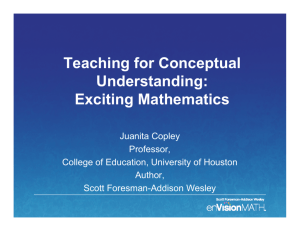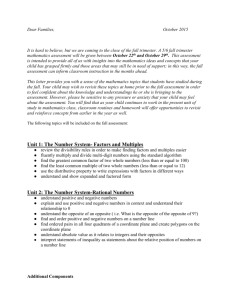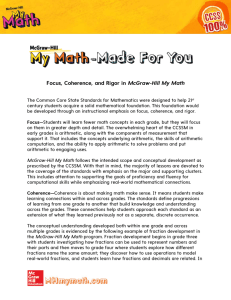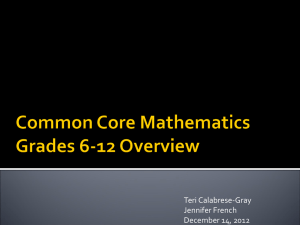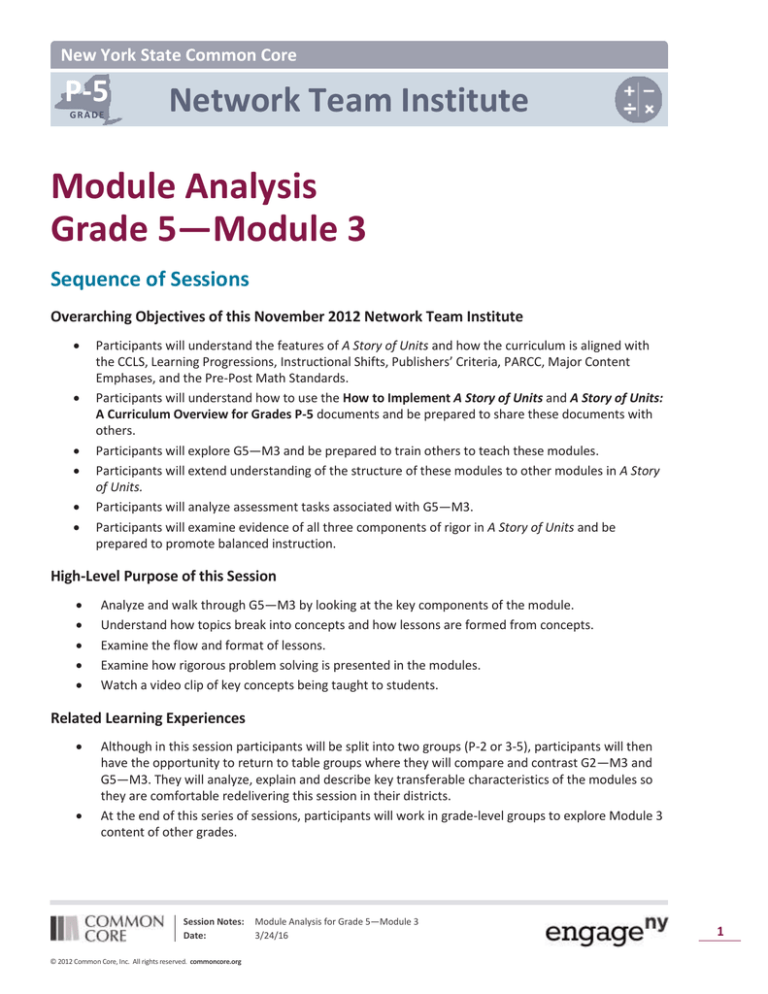
New York State Common Core
P-5
GRADE
Network Team Institute
Module Analysis
Grade 5—Module 3
Sequence of Sessions
Overarching Objectives of this November 2012 Network Team Institute
Participants will understand the features of A Story of Units and how the curriculum is aligned with
the CCLS, Learning Progressions, Instructional Shifts, Publishers’ Criteria, PARCC, Major Content
Emphases, and the Pre-Post Math Standards.
Participants will understand how to use the How to Implement A Story of Units and A Story of Units:
A Curriculum Overview for Grades P-5 documents and be prepared to share these documents with
others.
Participants will explore G5—M3 and be prepared to train others to teach these modules.
Participants will extend understanding of the structure of these modules to other modules in A Story
of Units.
Participants will analyze assessment tasks associated with G5—M3.
Participants will examine evidence of all three components of rigor in A Story of Units and be
prepared to promote balanced instruction.
High-Level Purpose of this Session
Analyze and walk through G5—M3 by looking at the key components of the module.
Understand how topics break into concepts and how lessons are formed from concepts.
Examine the flow and format of lessons.
Examine how rigorous problem solving is presented in the modules.
Watch a video clip of key concepts being taught to students.
Related Learning Experiences
Although in this session participants will be split into two groups (P-2 or 3-5), participants will then
have the opportunity to return to table groups where they will compare and contrast G2—M3 and
G5—M3. They will analyze, explain and describe key transferable characteristics of the modules so
they are comfortable redelivering this session in their districts.
At the end of this series of sessions, participants will work in grade-level groups to explore Module 3
content of other grades.
Session Notes:
Date:
© 2012 Common Core, Inc. All rights reserved. commoncore.org
Module Analysis for Grade 5—Module 3
3/24/16
1
Module Analysis for G5—M3
NYS COMMON CORE MATHEMATICS PD
Key Points
•
•
•
•
•
•
A Story of Units: A Curriculum Overview for Grades P-5 provides a curriculum map and grade level
overview.
The Standards come to life through the lessons.
Modules contain topics, topics break into concepts, and concepts become lessons.
Rigorous problems are embedded throughout the module.
The lesson format supports all Instructional Shifts.
G5—M3 exemplifies the key components of each module in the curriculum.
Session Outcomes
What do we want participants to be able to do as a result of this session?
Understand the structure of a module and its key components, and be able to transfer this
understanding to other modules
Understand the teaching sequences in Module 3 and how to implement the instruction
Redeliver the information to teachers in their districts/schools
How will we know that they are able to do this?
Participants teaching Grade 5 will successfully teach Module 3 in accordance with the design of the
curriculum.
Participants responsible for redelivering this information will successfully do so and their teachers will
begin instruction of G5—M3.
Session Overview
Section
Opening
Time
0:00-0:05
(5 min)
Walk Through and
Analyze Module
Components
0:05-0:35
(30 min)
Analyze Lesson
Components of
Module
0:35-0:55
(20 min)
Overview
Frame this session, referencing
workshop agenda
Introduce objectives and sequence
for this session
Walk through G5—M3
Examine module components
Examine topic and lesson
components
Identify key assessments in the
module
Analyze Lesson Components
Reflections/Turn and Talk
Session Notes:
Date:
© 2012 Common Core, Inc. All rights reserved. commoncore.org
Prepared Resources
Session PowerPoint
Facilitator Preparation
Review session notes and
PowerPoint presentation
Grade 5—Module 3
Session 2 Reflections Handout
Grade 5—Module 3
Session 2 Reflections Handout
Module Analysis for Grade 5—Module 3
3/24/16
2
NYS COMMON CORE MATHEMATICS PD
A Look at Rigorous
Problems in the
Module
0:55-1:10
(15 min)
Video Clip
1:10-1:20
(10 min)
Closing
1:20-1:30
(10 min)
TOTAL TIME
90 min
Take a high level glance at
examples of rigor in the module
Examine rigorous problems in G5—
M3
Reflections/Turn and Talk
Watch video clip of key concepts
being taught
Share observations
Summarize key points
Module Analysis for G5—M3
Grade 5—Module 3
Session 2 Reflections Handout
Solve the homework problems
using the models/strategies
demonstrated in the lesson
Video Clip: Interpret a Fraction as
Division
Review and download video file as
a back-up in case there is a
problem with the embedded clip
• Session 2 Reflections Handout
Session Roadmap
Opening
Time: 0:00-0:05
[5 minutes] In this section, you will…
Frame this session, referencing workshop agenda
Introduce objectives and sequence for this session
Materials used include:
Session PowerPoint
(SLIDE 1) We have had an opportunity to look at all of the documents that have been incorporated into the design of A
Story of Units in addition to the How to Implement A Story of Units document, which shows our approach to teaching
math aligned with the CCLS. We have also examined the curriculum map which gives us a global view of the coherence
of the curriculum. Two modules have been prepared for this institute: Grade 2—Module 3 and Grade 5—Module 3.
(SLIDE 2) In this session we will become acquainted with G5—M3. You will have an opportunity to:
Analyze and walk through G5—M3 by looking at the key components of the module.
Understand how topics break into concepts and how lessons are formed from concepts.
Examine the flow and format of lessons.
Examine how rigorous problem solving is presented in the modules.
Watch a video clip of key concepts being taught to students.
We anticipate that you will find the module and its components to be useful tools in supporting the evaluation process
of your district and state.
Walk Through and Analyze Module Components
Time: 0:05-0:35
Session Notes:
Date:
© 2012 Common Core, Inc. All rights reserved. commoncore.org
Module Analysis for Grade 5—Module 3
3/24/16
3
NYS COMMON CORE MATHEMATICS PD
Module Analysis for G5—M3
[30 minutes] In this section, you will…
Walk through G5—M3
Examine module components
Examine topic and lesson components
Identify key assessments in the module
Materials used include:
G5—M3
Session 2 Reflections Handout
(SLIDE 3) In this session you will have an opportunity to walk through and analyze the module components of Grade
5—Module 3.
(SLIDE 4) Turn to the beginning of Grade 5—Module 3, and follow through the module as we discuss the various
components. The module begins with the title and Table of Contents. On the following page begins the Module
Overview, which contains several pieces. We are going to examine the module piece by piece, starting with the
Module Overview.
Turn to page ii and read through the Overview section. After reading the text portion, you can skim through the Focus
Standards, Foundational Standards, and Focus Standards for Mathematical Practice, stopping at the end of page vi.
(SLIDE 5) After you read, reflect on these reflection questions:
•
What is this module about?
•
What is the purpose of the Overview?
You have 2 minutes to read and reflect. (Allow 2 minutes.) Take 2 minutes now to turn and talk with a
partner at your table about your answers to the reflection questions. (Allow 2 minutes and then
facilitate a discussion.)
(SLIDE 6) For the next four minutes, read through the Overview of Module Topics and Focus Lessons
chart that begins on page viii, and answer the following questions. You may work with a partner at your
table. (Allow 4 minutes for participants to work together, and then facilitate a discussion.)
How many topics are covered in the module?
What standards are covered in the module?
How many days of instruction are needed for the module?
How many lessons comprise the module?
When do you administer the assessments for the module?
(SLIDE 7) Let’s summarize the information contained in the Overview of Module Topics and Focus Lessons chart:
•
Lists the teaching sequence towards attaining mastery of the Standard highlighted in each lesson.
•
Teaching sequences are the appropriate sequential order for developing mathematics skills.
Session Notes:
Date:
© 2012 Common Core, Inc. All rights reserved. commoncore.org
Module Analysis for Grade 5—Module 3
3/24/16
4
NYS COMMON CORE MATHEMATICS PD
•
Module Analysis for G5—M3
Teachers “build a ladder” and start at the lowest rung of the ladder, and helps the students to climb the
rungs of the ladder as they develop conceptual understanding, synthesizing and applying knowledge from
earlier concepts in the module and concepts from earlier modules to strengthen deep conceptual
understanding.
(SLIDE 8) The next section in the Module Overview is New and Familiar Fluencies. Fluency activities promote
automaticity of skills, allowing students to reserve cognitive resources for higher level thinking. Take a moment to read
through the list of new and familiar fluency topics given on page ix. (Allow 30 seconds.)
Go ahead now and browse the Terminology section that follows Fluency. (Allow 30 seconds.)
Now, take a quick look at the Suggested Tools and Representations on pages x and xi. We will return for an in-depth
look at these as we explore the topic lessons. (Allow 15 seconds).
(SLIDE 9) The Common Core State Standards for Mathematics require that “all students must have the opportunity to
learn and meet the same high standards if they are to access the knowledge and skills necessary in their post-school
lives.”
The writers of A Story of Units agree and feel strongly that accommodations cannot be just an extra set of resources for
particular students. Instead, scaffolding must be folded into the curriculum in such a way that it is part of its very DNA.
The modules that make up A Story of Units propose that the components of excellent math instruction do not change
based on the audience. That said, there are specific resources included within this curriculum to highlight strategies
that can provide critical access for all students.
(SLIDE 10) Researched-based Universal Design for Learning (UDL) has provided a structure for thinking about how to
meet the needs of diverse learners. Broadly speaking, that structure asks teachers to consider multiple means of
representation; multiple means of action and expression; and multiple means of engagement.
(SLIDE 11) Charts at the end of this section offer suggested scaffolds, utilizing this framework, for English Language
Learners, Students with Disabilities, Students Performing above Grade Level, and Students Performing below Grade
Level.
(SLIDE 12) Take a look at the Scaffolds Charts in the module. Notice in the Scaffolds Chart how the universal design
principles are taken into consideration. Take a minute to read over the Scaffolds Chart. As you read, identify
accommodations that are already being used during math instruction in your class/school/district. (Allow 1 minute.)
(SLIDE 13) A Story of Units has another feature in the module to support teachers in differentiating instruction.
Individual lessons contain marginal notes to teachers (in text boxes) highlighting specific scaffolds that might be
employed with particular intentionality when working with different student populations. These tips are strategically
placed in the lesson where the teacher might use the strategy to the best advantage.
(SLIDE 14) Look through the marginal notes on scaffolding for Topic A. Find an example you like to
share with a partner at your table. (Allow 3 minutes.)
Session Notes:
Date:
© 2012 Common Core, Inc. All rights reserved. commoncore.org
Module Analysis for Grade 5—Module 3
3/24/16
5
NYS COMMON CORE MATHEMATICS PD
Module Analysis for G5—M3
(SLIDE 15) Now let’s examine the topics and lessons themselves. Turn to page 3.A.1. Every topic begins with a Topic
Opening made up of :
•
Focus standard(s), instructional days, and coherence links. One of the instructional shifts calls for coherence
within and between grades. This feature specifies the coherence links for the given topic.
•
Introductory paragraph
•
Concept chart listing the appropriate sequential order for developing mathematics concepts
•
Mathematical Practices Brought to Life
Notice that the page numbers indicate the current topic.
Topic A has one concept, therefore there is one lesson. Turn to page 3.B.1, notice that there are 2 concepts and
therefore 2 lessons. A lesson is developed for each concept. Let’s explore Topic A and look at the lesson structure more
carefully.
(SLIDE 16) Each lesson begins with the Suggested Lesson Structure Pie Graph that shows the breakdown of the lesson.
Note that the order of the lesson structure is suggested and can change from one lesson to the next.
(SLIDE 17) Fluency Practice includes notes to provide guidance to the teachers on interaction with students to prompt
ways of thinking and notes to provide guidance on the lesson flow as outlined in the Publishers’ Criteria.
(SLIDE 18) Most lessons contain one or more application problems.
(SLIDE 19) The Concept Development constitutes the major portion of instruction and generally comprises at least 20
minutes of the total lesson time. It is the primary lesson component, in which new learning is introduced. Concept
Development articulate the standards and topics through a deliberate progression of material, from concrete to
pictorial to abstract.
(SLIDE 20) Talk with a partner at your table about what you notice about the layout of the Concept
Development section of the lesson. (Allow 2 minutes, then facilitate a discussion.)
(SLIDE 21) The next component of the Suggested Lesson Structure is the Student Debrief. After the dynamic action of
the lesson has taken place, we reflect back with the students to analyze the learning that occurred. We encourage
them to articulate the focus of the lesson, developing students’ metacognition by making connections between parts of
the lesson, concepts, strategies and tools on their own. We draw out or introduce key vocabulary by helping students
appropriately name the learning they describe.
(SLIDE 22) Each lesson contains daily assessments in the form of worksheets, exit tickets, and homework sheets.
These assignments are done either independently or with teacher guidance, and can be graded in class as part of the
lesson. The worksheets often include fluency pertaining to the Concept Development, as well as conceptual and
application word problems. The goal is for students to apply the conceptual understanding learned during the lesson.
(SLIDE 23) Each module has an accompanying section for Supplementary Materials, which includes the Assessment
Tasks and Fluency Progressions.
•
Assessment Tasks identify key assessments in the module; there is an end of module task, a mid-module task
Session Notes:
Date:
© 2012 Common Core, Inc. All rights reserved. commoncore.org
Module Analysis for Grade 5—Module 3
3/24/16
6
NYS COMMON CORE MATHEMATICS PD
•
Module Analysis for G5—M3
and short daily assessments as exit tickets for each lesson.
The Fluency Progressions assist with planning. These materials are banks of activities that teachers may either
select and use, or study as they create their own. The bank of fluency activities for each lesson is intentionally
organized so that activities revisit previously learned material to develop automaticity, anticipate future
concepts, and strategically preview or build skills for the day’s Concept Development.
(SLIDE 24) Reflection: What are the strengths of the Module in implementing the CCLS for
Mathematics? Record the strengths on the Session 2 Reflections Handout page provided in your
binder.
Discuss the strengths of the module with a partner at your table, and then record how it compares with
instructional materials that you have used in the past.
(SLIDE 25) Key Points:
A Story of Units includes 5-7 modules for each grade level. A curriculum map and grade level overviews are
provided in A Story of Units: A Curriculum Overview for Grades P-5.
Topics break into concepts and concepts become lessons. The concepts may be displayed in the classroom
as the learning objectives for the lessons.
Analyze Lesson Components of Module
Time: 0:35-0:55
[20 minutes] In this section, you will…
Analyze Lesson Components
Reflections/Turn and Talk
Materials used include:
Lessons from Module
Session 2 Reflections Handout
(SLIDE 26) Participants will walk through and analyze each component of the module. Careful attention will be given to
looking at the lesson components.
(SLIDE 27) Notice the Distribution of Instructional Minutes Diagram and how the scripting helps to visualize what is
happening in each part of the lesson and serves as a guide. There may be a different time allotment for each part of the
lesson based upon the content. In the Publishers’ Criteria, there is an expectation of variety in the pacing and grain size
of content coverage. Sometimes and individual content standard will require days of work, while other standards will
be sufficiently addressed when grouped with other standards.
(SLIDE 28) The actual order in each lesson is determined by the content and pedagogy of the lesson. Fluency is usually
first—by beginning class with animated, adrenaline-rich fluency, students are more alert when presented with the
Concept Development and Application Problems.
Session Notes:
Date:
© 2012 Common Core, Inc. All rights reserved. commoncore.org
Module Analysis for Grade 5—Module 3
3/24/16
7
NYS COMMON CORE MATHEMATICS PD
Module Analysis for G5—M3
(SLIDE 29) Turn and talk with a partner at your table about these questions. (Allow 1 minute for turn
and talk, and then facilitate a discussion.)
What is another possible order for the lesson components?
What is the rationale for structuring the lesson in such an order?
(SLIDE 30) For example, another lesson structure may follow this order:
Exploration and Application Problems leading into the Concept Development (35 minutes)
Student Debrief (10 minutes)
Fluency Practice (15 minutes)
The placement of an application problem may go before or after the Concept Development. Many times placing a word
problem before the Concept Development can provide important structure to understanding a new concept. Other
times a word problem shows the value and usefulness of a just-learned concept. This is not the only way to meet the
demands for quality instruction.
In some modules, the structure may loosen a bit, with the lesson opening with exploration, investigation, a Concept
Development, or word problem followed by fluency, or even possibly omitting fluency periodically.
Lesson Analysis
(SLIDE 31) Pick one lesson from G5—M3 to analyze. As you analyze the lesson, reflect on these
questions and record your responses on the Session 2 Reflections Handout. After this activity, you will
have a chance to share your thoughts with a partner at your table.
(SLIDE 32) Lesson Analysis
What is the suggested lesson structure for the lesson that you chose to review and analyze?
Does the lesson you selected progress from concrete to pictorial to abstract sequence? If not,
which level of concept development is the focus of your lesson and why?
Turn and talk with a partner at your table about your reflections of the first two guiding questions
about the Lesson Analysis activity. (Allow 2 minutes for turn and talk, and then facilitate a discussion.)
(SLIDE 33) Reflect now on these additional questions about the lessons:
What do you notice about the fluency portion of the lesson?
• How is the concept developed in the lesson?
• Describe the Application part of the lesson.
• What is the student debrief? Why is it important?
Turn and talk with a partner about at your table about your reflections of the questions about fluency,
concept development, application and the student debrief. (Allow 2 minutes for turn and talk, and
then facilitate a discussion.)
Session Notes:
Date:
© 2012 Common Core, Inc. All rights reserved. commoncore.org
Module Analysis for Grade 5—Module 3
3/24/16
8
NYS COMMON CORE MATHEMATICS PD
Module Analysis for G5—M3
(SLIDE 34) Reflect on these questions about assessments and scaffolding in the lesson you chose to
analyze for 1 minute. Record your responses on the Session 2 Reflections Handout.
• What types of assessments are included in the lesson?
• Where is there evidence of scaffolding in the lesson you selected to review and analyze (i.e., for
diverse learners including ELLS, SWDs, advanced learners, struggling learners)?
Turn and talk with a partner at your table about the assessments and scaffolding in the lesson you
chose to analyze.
(SLIDE 35) Key Points:
•
•
•
The Distribution of Instructional Minutes Diagram displays the 3 components of rigor.
The Suggested Lesson Structure pie chart shows the breakdown of a lesson based upon a 60 minute class.
The Publishers’ Criteria emphasize that materials must reflect the Standards’ balanced approach to
mathematics, stressing conceptual understanding as well as procedural skill and fluency. There is a balance of
activities and tasks and a balance of how time is spent.
A Look at Rigorous Problems in the Module
Time: 0:55-1:10
[15 minutes] In this section, you will…
Take a high level glance at examples of rigor in the module
Examine rigorous problems in G5—M3
Reflections/Turn and Talk
Materials used include:
Homework problems from G5—M3
(SLIDE 36) We know that in order to help students become successful in meeting the expectations of the Standards, we
as educators must pursue, with equal intensity, the three aspects of rigor in the major work of each grade: conceptual
understanding, procedural skill and fluency, and applications. All of these components of rigor are evident in the
module. We will look at evidence of rigor more in-depth tomorrow, but we’d like to show you examples of how the
three components of rigor (fluency, application, and conceptual understanding) are imbedded throughout the module.
Turn to 3.B.1. Look through lesson 1 and find each of the three rigor components.
(SLIDE 37) The lessons have daily assessments in the form of worksheets, exit tickets, and homework assignments.
These daily assessments not only inform the teacher, but they also make students aware of their strengths and
weaknesses, giving them opportunities to try again and do better as their skill and understanding increases.
Rigor in the Assessments
(SLIDE 38) Each module contains a mid-module and end-of-module assessment task. See pages ___ and ___.
The Mid-Module Assessment Tasks are specifically tailored to address a portion of the student learning
Session Notes:
Date:
© 2012 Common Core, Inc. All rights reserved. commoncore.org
Module Analysis for Grade 5—Module 3
3/24/16
9
NYS COMMON CORE MATHEMATICS PD
Module Analysis for G5—M3
outcomes for which the module is designed.
The End-of-Module Assessment Tasks are summative and are specifically designed based on the standards
addressed in order to gauge students’ full range of understanding of the module as a whole and to prepare
them for PARCC assessments. We will explore the assessment tasks in more depth on tomorrow.
The Cross Modular Assessments are administered after modules 2, 4, and 6. These assessments are based on
standards from multiple modules.
Each assessment utilizes a combination of problems that build from simple to complex, and are designed to encourage
students to demonstrate procedural skill, fluency, and conceptual understanding.
(SLIDE 39) The assessments in A Story of Units provide students with an opportunity to show their learning
accomplishments in addition to offering students a pathway to monitor their progress, celebrate successes, examine
mistakes, uncover misconceptions and engage in self-reflection and analysis. Now we will take a look at how the
homework problems in A Story of Units are designed to build upon what students learn in the lesson for the day. The
homework sheet provides opportunities for students to check their understanding and confirm they can solve problems
independently.
(SLIDE 40) Select one of the homework problem sheets from G5—M3. You may remove the page from
your binder and place it inside of your personal dry erase board. Examine the problem then solve the
problem using your dry erase marker and personal dry erase board.
Note: As participants are solving the problems, the facilitator walks around to identify 4 participants who are solving
different types of problems that show the variety of problem types that are designed to elicit a variety of student
responses. Each of the selected participants will select a problem from the homework sheet to share on the
document camera. (Participants share how students are expected to respond to the selected problem.)
(SLIDE 41) Examining Homework Problems in the Module: Now that you have had an opportunity to
solve some of the homework problems in G5—M3, turn and talk with a partner at your table about
these questions: (Allow participants 2 minutes to discuss these questions at their tables.)
Where is there evidence of the Mathematical Content Standards and Standards for
Mathematical Practice in these problems?
Where is there evidence of the components of rigor (fluency, conceptual understanding, and
application)?
(SLIDE 42) Students are exposed to a variety of problems designed to elicit multiple representations and
explanations. The Publishers’ Criteria state that the activities that students do and the problems they work on must
exhibit balance along various dimensions. For example, some activities and tasks should call for procedural skill and
fluency alone, others should call for conceptual understanding, still others should require skill and understanding in
equal measure.
(SLIDE 43) Here are key points about rigor in the module:
Key Points:
Rigorous problems that produce a variety of student responses are embedded throughout the module.
For these problems, answers alone are insufficient. Students must be able to thoroughly explain their thought
processes. Possible student work may include bar diagrams, number sentences, area models, paragraphs, etc.
Session Notes:
Date:
© 2012 Common Core, Inc. All rights reserved. commoncore.org
Module Analysis for Grade 5—Module 3
3/24/16
10
NYS COMMON CORE MATHEMATICS PD
Module Analysis for G5—M3
Video Clip of Place Value Concept
Time: 1:10-1:20
[10 minutes] In this section, you will…
Watch video clip of key concepts being taught
Share observations
Materials used include:
Video Clip: Interpret a Fraction as Division
(SLIDE 44) We have captured a video clip for you to see a fraction concept in action in the classroom.
(SLIDE 45) As you watch this video clip, reflect on these questions:
•
How did the teacher help students develop conceptual understanding?
Which Standards for Mathematical Practice did the students demonstrate as they engaged in the lesson?
Where did you see evidence of the three components of rigor in the video?
After the video, you will have a chance to share your thoughts with a partner at your table.
The teacher in the video is Anita Meadows with her 5th Grade is grade students at Saint Edwards’
School in Vero Beach, FL. In the video clip you will see the teacher and students engaged in a lesson on
interpreting fractions as division.
Prior to what you will see in the video clip, the teacher began the lesson by engaging students in a
number of examples where they interpreted a fraction as division of the numerator by the
denominator (a/b = a ÷ b from Standard 5.NF.3).
(SLIDE 46 – Play Video Clip: Interpret a Fractions as Division)
(SLIDE 47) Turn and talk with a partner at your table about your reflections of the video. (Allow 2
minutes for turn and talk, and then facilitate a discussion.)
How did the teacher help students develop conceptual understanding?
Which Standards for Mathematical Practice did the students demonstrate as they engaged in the
lesson?
Where did you see evidence of the three components of rigor in the video?
Closing
Time: 1:20-1:30
[10 minutes] In this section, you will…
Share evidence of rigor
Summarize key points
Session Notes:
Date:
© 2012 Common Core, Inc. All rights reserved. commoncore.org
Module Analysis for Grade 5—Module 3
3/24/16
11
NYS COMMON CORE MATHEMATICS PD
Module Analysis for G5—M3
Materials used include:
Session 2 Reflections Handout
(SLIDE 48) Now that we have had an opportunity to examine the components of G5—M3, we’d like to
provide time for you to reflect and make notes of your biggest takeaways of evidence of the three
components of rigor in G5—M3. On the Session 2 Reflections Handout, list examples of the
components of rigor (fluency, conceptual understanding and application) in G5—M3 that you observed.
(Allow 1 minute for participants to record reflections.)
Turn and talk with a partner at your table about your biggest takeaways from this session. (Allow 2
minutes for turn and talk, and then facilitate a discussion.)
(SLIDE 49) Let’s review the key points of this session:
•
A Story of Units: A Curriculum Overview for Grades P-5 provides a curriculum map and grade level overview.
The curriculum map provides an at-a-glance view of the entire story, making clear the coherence of the
curriculum and the role that G5—M3 plays in that progression.
The Standards, both Content and Practice, come to life through the lessons.
Each grade contains 5-7 modules. Modules contain topics, topics break into concepts, and concepts become
lessons.
Rigorous problems are embedded throughout the module.
The lesson format supports all Instructional Shifts. The Distribution of Instructional Minutes Diagram displays
the 3 components of rigor. The Lesson Structure Pie Graph shows the breakdown of a lesson based upon a 60
minute class period.
The key components of G5—M3 exemplify the key components that will comprise each module in the
curriculum.
The Publishers’ Criteria emphasizes that materials must reflect the Standards’ balanced approach to mathematics,
stressing both conceptual understanding as well as procedural skill and fluency. There is a balance of activities
and tasks and a balance of how time is spent.
(SLIDE 50) Take a moment to reflect on these next steps using the Session 1 Reflections Handout.
(Record on the Session 2 Reflections Handout.)
How can you transfer what you know about the structure of a module and its key components
to next steps in the planning process?
What is your plan for sharing G5—M3 with the administrators/teachers at your
school(s)/districts(s)?
What is your plan for redelivery of this session?
(SLIDE 53 – IF TIME ALLOWS, HAVE PARTICIPANTS ENGAGE IN FOLLOW-UP EXPLORATION OF G2—M3 AND G5—M3
Session Notes:
Date:
© 2012 Common Core, Inc. All rights reserved. commoncore.org
Module Analysis for Grade 5—Module 3
3/24/16
12
NYS COMMON CORE MATHEMATICS PD
Module Analysis for G5—M3
USING THIS AND THE FOLLOWING SLIDES.)
(SLIDE 51) The purpose of this follow-up is to give you an opportunity to talk through your understandings of these
modules and share your thoughts with colleagues. You will have time to share your observations of each module,
compare the two modules, and analyze key components that can be extended to all modules in A Story of Units.
(SLIDE 52) Some of you have participated in a module analysis of Grade 2—Module 3, while others of
you participated in analysis of Grade 5—Module 3. Take some time now to share with each other what
you’ve learned about the two modules. Use these guiding questions to prompt your discussion. (Allow
participants to work at their tables for about 20 minutes, and then facilitate a discussion.)
What are the strengths of the module?
What questions do you have about the module?
How is conceptual understanding developed from simple to complex in G2—M3 and G5—M3?
(SLIDE 53) Now that you all have a good understanding of both modules, take time to compare and
contrast the two modules. Use these guiding questions to prompt your discussion. (Allow participants
to work at their tables for about 20 minutes, and then facilitate a discussion.)
What are the similarities in the structure of G2—M3 and G5—M3?
How are the two modules different?
(SLIDE 54) Based on this discussion, what can you determine are the key components of the module
structure, and how can this information help you with future modules? (Allow participants to work at
their tables for about 20 minutes, and then facilitate a discussion.)
What are consistent themes across G2—M3 and G5—M3 that are aligned with the CCLS and
the major documents?
How will knowledge of these modules prepare you for understanding future modules?
Turnkey Materials Provided
Session PowerPoint
Homework Problems from G5—M3 (provided in module)
Session 2 Reflections Handout
Video Clip: Interpret a Fraction as Division
Additional Suggested Resources
Session Notes:
Date:
© 2012 Common Core, Inc. All rights reserved. commoncore.org
Module Analysis for Grade 5—Module 3
3/24/16
13



